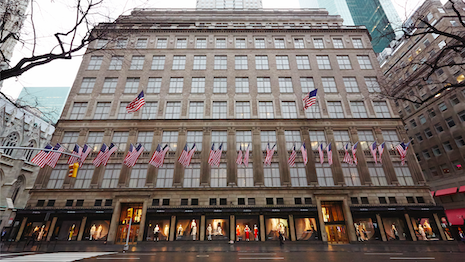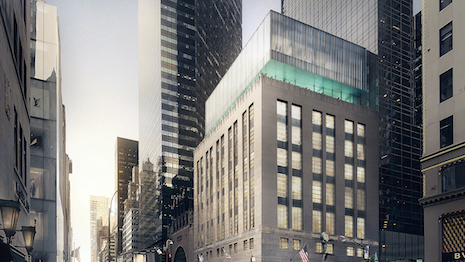- About
- Subscribe Now
- New York,
September 24, 2020

 Saks Fifth Avenue flagship store in New York across from Rockefeller Center. Image courtesy of Saks Fifth Avenue
Saks Fifth Avenue flagship store in New York across from Rockefeller Center. Image courtesy of Saks Fifth Avenue
NEW YORK – While the coronavirus pandemic brought physical shopping to a halt at upscale corridors around the world, there is now an opportunity for luxury brands to reevaluate their flagship stores.
During a fireside chat at the Future of Luxury eConference, an executive from the Fifth Avenue Association reiterated how bricks-and-mortar retail is essential to the perception of luxury brands. Luxury flagships present a unique opportunity for brands to build and maintain connections with consumers.
“One of the open secrets of Fifth Avenue is a critical mass of cultural centers: hospitality, food outlets and restaurants and then the merchants themselves,” said Jerome Barth, president of the Fifth Avenue Association. “This creates a complete experience rather than just a shopping experience.”
Future of Luxury eConference was produced by Luxury Daily
Fifth Avenue experiences
Manhattan’s Fifth Avenue is arguably the most iconic shopping corridor in North America.
Fifth Avenue is the home of flagships for several LVMH brands, Kering’s Gucci, U.S. jewelers Tiffany & Co. and Harry Winston, among others. Other popular stores on the avenue that attract affluent shoppers include Nike and Lululemon, according to Mr. Barth.
Prior to the pandemic, nearby luxury hotels including the Four Seasons, The Pierre and Rosewood’s The Carlyle supplied retailers a steady stream of tourists with appetites to spend. World-class museums also helped Fifth Avenue rise beyond a shopping destination to a cultural center.
A drop-off in travel and tourism, particularly among Chinese consumers, has impacted Western luxury brands.
According to Bain & Company, Chinese consumers made 27 percent of their luxury purchases in China in 2018, meaning that almost three-quarters of luxury purchases were made overseas before the pandemic. Because of how hard the U.S. was hit by COVID-19, tourism may not recover as quickly once borders are reopened (see story).
As the economy in New York reopens, Mr. Barth urges brands to stay true to the meaning of a flagship boutique.
 Exterior rendering of the renovated Tiffany & Co. flagship on Fifth Avenue. Image courtesy of Tiffany & Co.
Exterior rendering of the renovated Tiffany & Co. flagship on Fifth Avenue. Image courtesy of Tiffany & Co.
He cited experiences where he visited mass-market retailers, including the reopened Apple flagship in New York, and was unable to access the products or services he sought. Instead, the options were only available online, instead of in-store as one may expect from a landmark location.
“If you’re going to invest in a flagship, what is the point of an online exclusive?” Mr. Barth asked.
Retail future?
Mr. Barth also suggests that brands consider stores another form of media or marketing that should offer emotional resonance.
Prior to the pandemic, luxury brands had begun embracing more experiential strategies for their bricks-and-mortar locations.
Department store chain Nordstrom first opened its New York store, it was an experiential environment, with food and beverage destinations that mingled with sales floors. For instance, the footwear department included a bar that enables shoppers to grab a drink while trying on shoes, creating a more convivial atmosphere (see story).
Meanwhile on Fifth Avenue, Tiffany & Co. is currently undergoing renovations at its New York City flagship. Originally built in 1940, construction on the Tiffany flagship began more than a year ago and is expected to be completed in spring 2022.
Exterior renderings reveal a Tiffany blue glass addition to three top floors of 727 Fifth Avenue, a modern addition to the landmark building. With future in-store events in mind, the new glass facade and addition will house an event and exhibition space (see story).
Beyond Fifth Avenue and New York, French luxury groups LVMH and Kering have reopened newly renovated and relocated stores in recent weeks. The new class of flagships manage to emphasize brands’ legacies while remaining pristine and safe stores (see story).
“You have to think of the store as media,” Mr. Barth said. “It is an opportunity to connect emotionally and make an imprint on the consumer.”
Share your thoughts. Click here